

(Download a higher resolution picture by clicking on any
picture below.) 
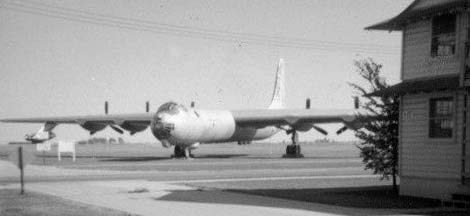 Barry Heiser photographed RB-36H 51-13730 on display at Chanute AFB in October 1964.
Barry Heiser photographed RB-36H 51-13730 on display at Chanute AFB in October 1964.
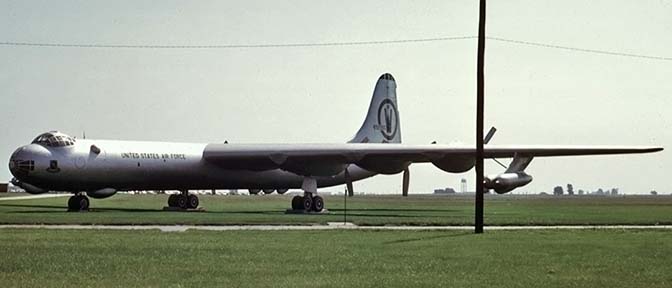 RB-36H Peacemaker when she was on display at Chanute AFB in Illinois in August 1972. They had her painted as 44-92065, which was a B-36B, later modified to B-36D standard. All of the airplanes on display at Chanute had fictitious tail numbers. When Chanute AFB closed down in the early nineties, the Peacemaker was transferred to the Castle Air Force Base Museum. Photographer: Brian Lockett.
RB-36H Peacemaker when she was on display at Chanute AFB in Illinois in August 1972. They had her painted as 44-92065, which was a B-36B, later modified to B-36D standard. All of the airplanes on display at Chanute had fictitious tail numbers. When Chanute AFB closed down in the early nineties, the Peacemaker was transferred to the Castle Air Force Base Museum. Photographer: Brian Lockett.
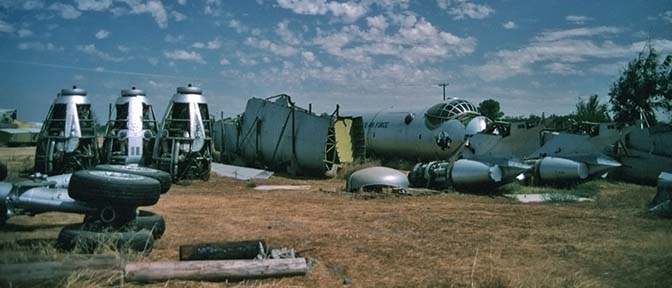 RB-36H 51-13730 is scattered in a field behind the Castle Air Force Base Museum. It had been disassembled to components that could be transported on railroad cars. Photographer: Brian Lockett.
RB-36H 51-13730 is scattered in a field behind the Castle Air Force Base Museum. It had been disassembled to components that could be transported on railroad cars. Photographer: Brian Lockett.
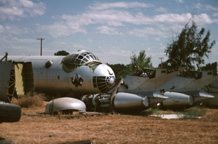 Over a period of a little more than
a year, the Peacemaker was reassembled. Photographer: Brian
Lockett.
Over a period of a little more than
a year, the Peacemaker was reassembled. Photographer: Brian
Lockett.
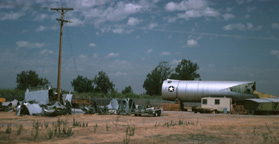 The rear fuselage is perched on
stacks of lumber. Various panels and fairings are stacked to the
side. Photographer: Brian Lockett.
The rear fuselage is perched on
stacks of lumber. Various panels and fairings are stacked to the
side. Photographer: Brian Lockett.
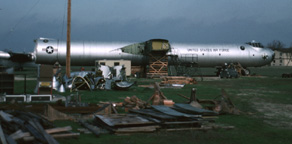 The forward fuselage and the wing
box have been joined to the rear fuselage. The nose landing gear
is place, but the fuselage and stub wings are resting on stacked
lumber. Photographer: Brian Lockett.
The forward fuselage and the wing
box have been joined to the rear fuselage. The nose landing gear
is place, but the fuselage and stub wings are resting on stacked
lumber. Photographer: Brian Lockett.
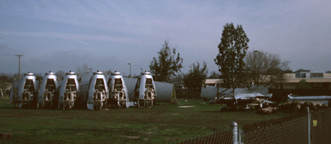 Six R-4360 engines and two pairs of
J-47 jets waiting their turn to be re-attached to the RB-36H.
Photographer: Brian Lockett.
Six R-4360 engines and two pairs of
J-47 jets waiting their turn to be re-attached to the RB-36H.
Photographer: Brian Lockett.
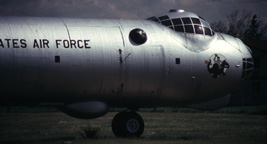 The nose of the RB-36H is resting
on its landing gear. Photographer: Brian Lockett.
The nose of the RB-36H is resting
on its landing gear. Photographer: Brian Lockett.
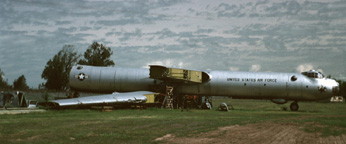 More wing structure has been
attached and the outer wing panels are resting nearby.
Photographer: Brian Lockett.
More wing structure has been
attached and the outer wing panels are resting nearby.
Photographer: Brian Lockett.
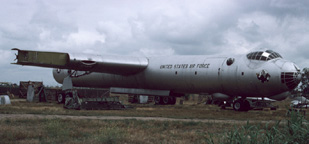 The Peacemaker is sitting on its
own wheels again. The leading edge of the wings and the bomb-bay
doors have been re-attached. Photographer: Brian Lockett.
The Peacemaker is sitting on its
own wheels again. The leading edge of the wings and the bomb-bay
doors have been re-attached. Photographer: Brian Lockett.
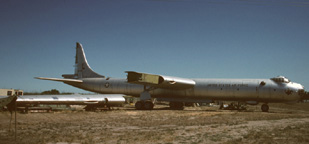 With the empennage back in place
the RB-36H is returned to its full length of 162 feet.
Photographer: Brian Lockett.
With the empennage back in place
the RB-36H is returned to its full length of 162 feet.
Photographer: Brian Lockett.
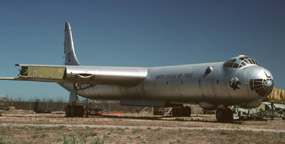 The vertical stabilizer brings the
height of the restored bomber back up to 47 feet. Photographer:
Brian Lockett.
The vertical stabilizer brings the
height of the restored bomber back up to 47 feet. Photographer:
Brian Lockett.
 The outer wing panels with the jet
engine pods are back in place. The full 230 foot wing span is
restored. Photographer: Brian Lockett.
The outer wing panels with the jet
engine pods are back in place. The full 230 foot wing span is
restored. Photographer: Brian Lockett.
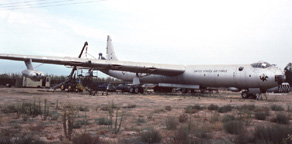 Preparations are underway to
install the six reciprocating engines. Photographer: Brian
Lockett.
Preparations are underway to
install the six reciprocating engines. Photographer: Brian
Lockett.
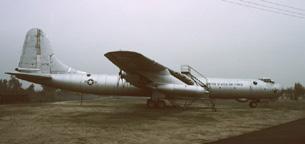 The Peacemaker is nearly complete.
The rudder, elevators, and flaps are back in their places. The
propellor spinners have yet to be installed. Photographer: Brian
Lockett.
The Peacemaker is nearly complete.
The rudder, elevators, and flaps are back in their places. The
propellor spinners have yet to be installed. Photographer: Brian
Lockett.
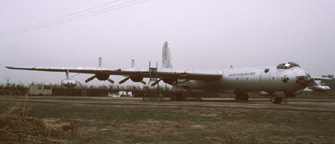 The six 4,360 cubic inch,
twenty-eight cylinder engines have been re-installed in the
trailing edge of the wing with their nineteen foot diameter,
three-bladed propellors. Photographer: Brian Lockett.
The six 4,360 cubic inch,
twenty-eight cylinder engines have been re-installed in the
trailing edge of the wing with their nineteen foot diameter,
three-bladed propellors. Photographer: Brian Lockett.
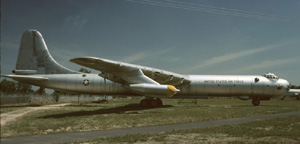 The RB-36H Peacemaker is completely
re-assembled, down to the propellor spinners. Photographer: Brian
Lockett.
The RB-36H Peacemaker is completely
re-assembled, down to the propellor spinners. Photographer: Brian
Lockett.
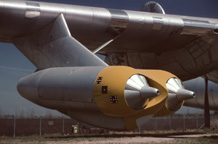 Soon after its introduction into
service, the B-36 design was augmented by a pair of J-47 jet
engines on each wing. These are the same pods as the inboard
nacelles of early models of the Boeing B-47. The pods were
purchased from Boeing by Convair. The B-47 was designed to fly
faster than the B-36, and its leading edges were more sharply
swept than was appropriate for the Peacemaker's cruising speed.
Notice how the leading edge of the pylon has a kink in it where
the B-47 nacelle pylon attaches to the stub pylon, which has a
more appropriate leading edge sweep for the cruising speed of the
RB-36H. The engine nacelle even incorporates the fairing that
enclosed the outrigger landing gear of the B-47. Photographer:
Brian Lockett.
Soon after its introduction into
service, the B-36 design was augmented by a pair of J-47 jet
engines on each wing. These are the same pods as the inboard
nacelles of early models of the Boeing B-47. The pods were
purchased from Boeing by Convair. The B-47 was designed to fly
faster than the B-36, and its leading edges were more sharply
swept than was appropriate for the Peacemaker's cruising speed.
Notice how the leading edge of the pylon has a kink in it where
the B-47 nacelle pylon attaches to the stub pylon, which has a
more appropriate leading edge sweep for the cruising speed of the
RB-36H. The engine nacelle even incorporates the fairing that
enclosed the outrigger landing gear of the B-47. Photographer:
Brian Lockett.
The metal petals filling the inlet prevented the jets from turning in the wind as the B-36 cruised for long periods of time with them turned off. The petals retracted to allow the jet engines to be ignited for extra thrust during take-off and high speed dashes. A strut braces the nacelle against swinging from side-to-side.
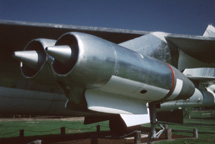 Here is nearly the same nacelle
design on the Castle Air Force Base Museum's Boeing B-47E
Stratojet. The inlets have been redesigned to accommodate the
larger airflow requirements of the later models of the J-47 jet
engine. On the Stratojet, the nacelle enclosed a single wheel
outrigger landing gear to balance the jet on its bicycle landing
gear. The B-47 nacelle did not require the inlet filling petals
of the B-36 version. Photographer: Brian Lockett.
Here is nearly the same nacelle
design on the Castle Air Force Base Museum's Boeing B-47E
Stratojet. The inlets have been redesigned to accommodate the
larger airflow requirements of the later models of the J-47 jet
engine. On the Stratojet, the nacelle enclosed a single wheel
outrigger landing gear to balance the jet on its bicycle landing
gear. The B-47 nacelle did not require the inlet filling petals
of the B-36 version. Photographer: Brian Lockett.
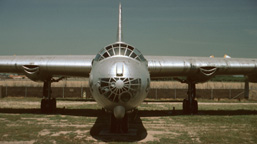 The cockpit and bombardier's
station have some of the most complex glazing found on any
airplane. Photographer: Brian Lockett.
The cockpit and bombardier's
station have some of the most complex glazing found on any
airplane. Photographer: Brian Lockett.
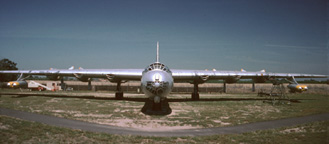 The biggest wing of any bomber ever
flown. Photographer: Brian Lockett.
The biggest wing of any bomber ever
flown. Photographer: Brian Lockett.
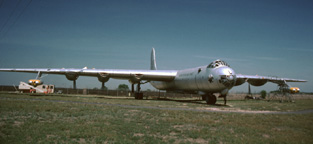 The three radomes that were
typically found on the lower rear fuselage of RB-36s were lost
before 51-13730 was delivered to Castle, although they can be
seen in the picture taken at Chanute AFB at the top of the page.
Photographer: Brian Lockett.
The three radomes that were
typically found on the lower rear fuselage of RB-36s were lost
before 51-13730 was delivered to Castle, although they can be
seen in the picture taken at Chanute AFB at the top of the page.
Photographer: Brian Lockett.
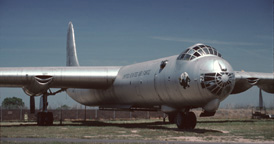 The glazing is still painted black.
Photographer: Brian Lockett.
The glazing is still painted black.
Photographer: Brian Lockett.
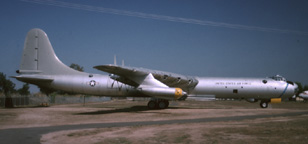 51-13730 has received a coat of
silver paint and a facelift. The old nose art has been replaced
with the starry blue sash of the Strategic Air Command. The
vertical stabilizer is now painted gray, which differs slightly
from the original appearance of the Peacemaker. The picture of
the RB-36H that appears on the Castle Air Museum website shows
that the stabilizer has been painted silver and additional
squadron markings have been applied. Photographer: Brian Lockett.
51-13730 has received a coat of
silver paint and a facelift. The old nose art has been replaced
with the starry blue sash of the Strategic Air Command. The
vertical stabilizer is now painted gray, which differs slightly
from the original appearance of the Peacemaker. The picture of
the RB-36H that appears on the Castle Air Museum website shows
that the stabilizer has been painted silver and additional
squadron markings have been applied. Photographer: Brian Lockett.
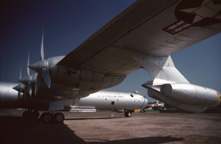 The large dark square on the
forward fuselage is an observation port in the reconnaissance
compartment. The most forward of the four bomb-bays of the bomber
variant of the B-36 was replaced with a pressurized compartment
in the reconnaissance version. A short connecting tunnel provided
access from the forward fuselage through the unpressurized
forward turret bay. An additional connecting tube ran back
through the bomb-bay to the rear fuselage. Photographer: Brian
Lockett.
The large dark square on the
forward fuselage is an observation port in the reconnaissance
compartment. The most forward of the four bomb-bays of the bomber
variant of the B-36 was replaced with a pressurized compartment
in the reconnaissance version. A short connecting tunnel provided
access from the forward fuselage through the unpressurized
forward turret bay. An additional connecting tube ran back
through the bomb-bay to the rear fuselage. Photographer: Brian
Lockett.
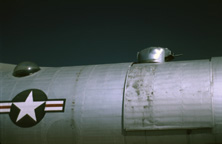 One of a pair of retractable
turrets, each equipped with two 20 millimeter cannon. The turret
door slides down the side of the bomber to expose the two
turrets. There is another pair of turrets on the forward fuselage
and a third pair on the lower rear fuselage, below this pair. The
gunners occupied the plexiglas bubbles. A mechanical analog
computer calculated the direction to point the turrets, taking
into account the necessary lead angle and the displacement of the
guns from the sighting blister. Photographer: Brian Lockett.
One of a pair of retractable
turrets, each equipped with two 20 millimeter cannon. The turret
door slides down the side of the bomber to expose the two
turrets. There is another pair of turrets on the forward fuselage
and a third pair on the lower rear fuselage, below this pair. The
gunners occupied the plexiglas bubbles. A mechanical analog
computer calculated the direction to point the turrets, taking
into account the necessary lead angle and the displacement of the
guns from the sighting blister. Photographer: Brian Lockett.
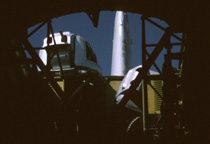 The retractable turrets viewed from
inside the bomber. The left turret is in the extended position
while the right turret is still retracted. Of the four survivors,
this is the only B-36 that still has its gun turrets.
Photographer: Brian Lockett.
The retractable turrets viewed from
inside the bomber. The left turret is in the extended position
while the right turret is still retracted. Of the four survivors,
this is the only B-36 that still has its gun turrets.
Photographer: Brian Lockett.
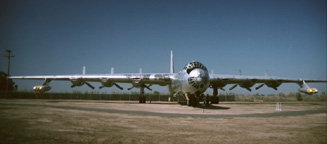 Some portions of the leading edge
of the wing needed reskinning. The magnesium skin had suffered
significant corrosion after sitting outside in Illinois for over
three decades. Photographer: Brian Lockett.
Some portions of the leading edge
of the wing needed reskinning. The magnesium skin had suffered
significant corrosion after sitting outside in Illinois for over
three decades. Photographer: Brian Lockett.
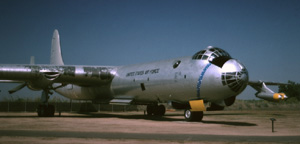 The nose landing gear doors have
received a coat of yellow paint. A black anti-glare panel has
been added in front of the cockpit. The black paint has been
stripped from the inside of the glazing. Photographer: Brian
Lockett.
The nose landing gear doors have
received a coat of yellow paint. A black anti-glare panel has
been added in front of the cockpit. The black paint has been
stripped from the inside of the glazing. Photographer: Brian
Lockett.
Several years passed between my visits to the Castle Museum. The RB-36H acquired additional unit identification markings.
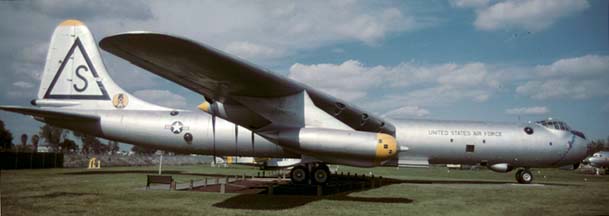 The triangle S on the tail denotes
the 28th SRW/BW of the 8th Air Force. The 28th was based at
Ellsworth AFB, South Dakota.
The triangle S on the tail denotes
the 28th SRW/BW of the 8th Air Force. The 28th was based at
Ellsworth AFB, South Dakota.
 Cross your eyes to see the RB-36H
in 3-D
Cross your eyes to see the RB-36H
in 3-D
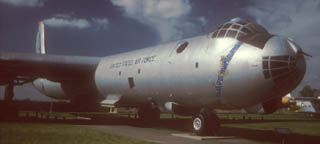 The
badge for the 28th SRW/BW has been added to the forward fuselage.
The
badge for the 28th SRW/BW has been added to the forward fuselage.
 The
port for the oblique camera is open.
The
port for the oblique camera is open.
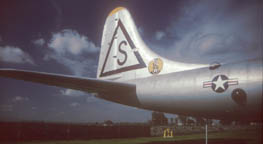 The
8th Air Force insignia graces the vertical stabilizer below the
unit ID.
The
8th Air Force insignia graces the vertical stabilizer below the
unit ID.
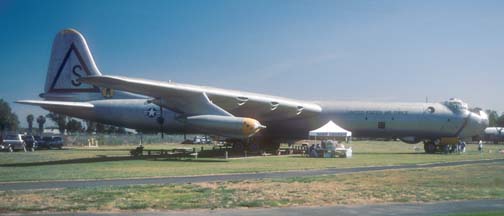 Castle Air
Museum near Atwater, California hosted Open Cockpit Days over the
weekend of May 25-26, 2002.
Castle Air
Museum near Atwater, California hosted Open Cockpit Days over the
weekend of May 25-26, 2002.
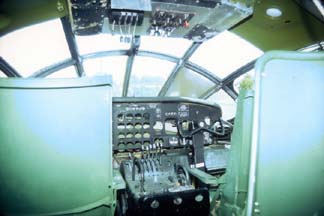 I took the opportunity to climb
inside the forward
crew compartment of their Convair RB-36H, 51-13730 and
photograph the various crew stations.
I took the opportunity to climb
inside the forward
crew compartment of their Convair RB-36H, 51-13730 and
photograph the various crew stations.
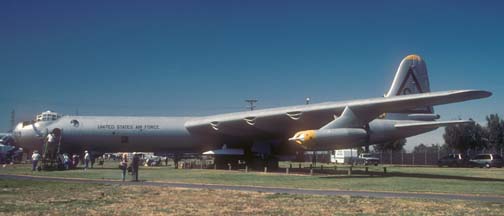 A Bell
GAM-63 Rascal missile can just be seen under the left wing of the
RB-36H.
A Bell
GAM-63 Rascal missile can just be seen under the left wing of the
RB-36H.
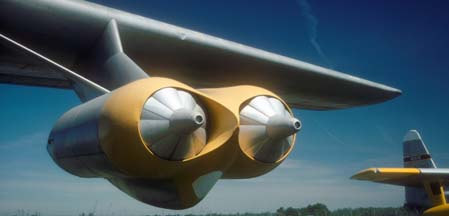 J-47 jet engine nacelle on RB-36H, 51-13730.
J-47 jet engine nacelle on RB-36H, 51-13730.
Link to the Castle Air Museum home page.
 Books about B-36 Peacemakers available from
Books about B-36 Peacemakers available from 
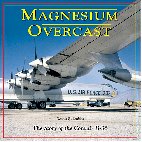 Dennis Jenkins has produced another large B-36 book: Magnesium Overcast.
Dennis Jenkins has produced another large B-36 book: Magnesium Overcast.
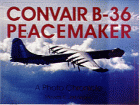 Meyers Jacobsen has authored
another book about the Convair B-36 Peacemaker: A Photo Chronicle.
Meyers Jacobsen has authored
another book about the Convair B-36 Peacemaker: A Photo Chronicle.
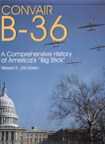 Convair B-36 : A Comprehensive History of America's
'Big Stick by Meyers K. Jacobsen. Mr. Jacobsen has been
compiling this history for at least a quarter of a century.
Convair B-36 : A Comprehensive History of America's
'Big Stick by Meyers K. Jacobsen. Mr. Jacobsen has been
compiling this history for at least a quarter of a century.
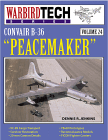 Warbird Tech: Convair B-36 Peacemaker . This volume by Dennis Jenkins contains a
surprising amount of information that did not get into "The
Big Stick".
Warbird Tech: Convair B-36 Peacemaker . This volume by Dennis Jenkins contains a
surprising amount of information that did not get into "The
Big Stick".
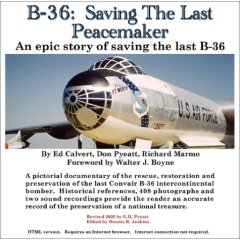 The history of the efforts to preserve B-36J, 52-22827 at Fort Worth is well documented in "B-36: Saving the Last Peacemaker"; Second Edition, an html book on CD. This CD-ROM is viewed with your internet browser.
The history of the efforts to preserve B-36J, 52-22827 at Fort Worth is well documented in "B-36: Saving the Last Peacemaker"; Second Edition, an html book on CD. This CD-ROM is viewed with your internet browser.
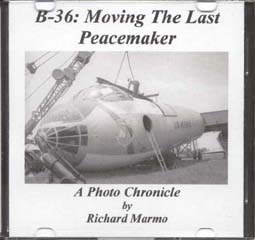 B-36: Moving the Last Peacemaker. These 875 photos show photographically the effort expended by all of the volunteers over a nine year period to save the aircraft. This CD-ROM is a self contained slide show that does not require a browser to view.
B-36: Moving the Last Peacemaker. These 875 photos show photographically the effort expended by all of the volunteers over a nine year period to save the aircraft. This CD-ROM is a self contained slide show that does not require a browser to view.
Send a message to Brian.
 Go to the main Convair B-36 page.
Go to the main Convair B-36 page.